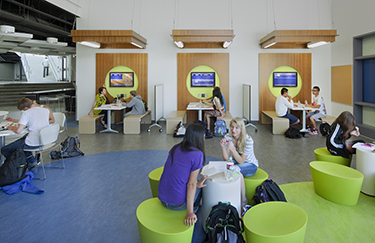|
Subscribe / Renew |
|
|
Contact Us |
|
| ► Subscribe to our Free Weekly Newsletter | |
| home | Welcome, sign in or click here to subscribe. | login |
Construction
| |
 |
August 28, 2014
What schools can learn from Starbucks
DLR Group

Ferking
|
I’d like to make a risky statement: The school library should be replaced with a coffeehouse.
I hope that you’re either excited or upset by that idea. First, because as an architect I love that people are passionate about their ideas of what a place should be. But more importantly because there are some crucial educational principles behind my proposal.
In creating schools today, we’ve seen a shift in district philosophies toward a greater emphasis on building relationships and school community. This isn’t to say that the desire for community is new, but rather our understanding of the value of community has expanded.
Safety and security (in the wake of school shootings) have been big drivers in appraisals of community; it’s arguable that school safety is less about barriers, and much more about the health of a school community. And our better understanding of how people learn has also driven these conversations, acknowledging the value of collaborative and project-based learning as well as applied learning opportunities through connections to local businesses and community organizations.
This shift is also occurring at the same time that we’re beginning to question the relevance of certain kinds of places, such as the library, thanks to dramatic changes in how we access stories, knowledge and information through new technology.
Coffeehouse as culture
Look inside your local coffeehouse. It can be a small business or a chain like a Starbucks. Today’s coffeehouse has transformed from a place into a culture. It is no longer a booth where adults sip a hot drink; it has become a multigenerational way of life.
Coffeehouses are artistic and intellectual. Students (and all visitors), can explore their creative side by participating in open mic nights, poetry readings, book signings and art exhibitions.
Coffeehouses provide a place to learn more about a special interest or to collaborate on a project. Wi-Fi is available, power outlets are abundant, and comfortable couches, tables and bar areas create the perfect escape — be it for a few minutes or many hours. In some communities coffeehouses are found on every corner, creating a convenient meeting spot for personal connections.
Kids today are living in an open, collaborative world outside of school, however inside the walls of a school many students are still learning in a fragmented environment that’s increasingly incongruous with how they best learn and connect with one another.
Students read in the library, complete lessons in a classroom, practice band and music in the music room, perform a skit in the auditorium and eat lunch in the cafeteria — a program of isolated spaces that persist based on longstanding assumptions about what a school should look like. All too often these spaces are too large or too institutional for students to actually want to be there. In contrast, the coffeehouse culture stems from the way we live: open, interconnected, comfortable.
A third place
A coffeehouse concept allows us to simplify our designs, creating flexibility to meet various needs.
Years ago, our approach to educational design was based on a singular modality — dining spaces were used for dining, classrooms were used for learning, and the auditorium was used for performing arts. Not only were these spaces separated, but often sized for utility and efficiency instead of real human interaction. Today’s concept allows us to exercise a hybrid approach to create interdisciplinary, multifunctional spaces that enrich the learning environment.
Imagine an intimate space featuring digital collaboration nodes with TV screens lining the walls, multiple seating formations, informal and formal gathering areas, a gallery to exhibit student work, and shared media options. It’s the coffeehouse culture integrated into space within a school.
Square footage is pulled from surrounding areas to create this in-demand coffeehouse vibe. The added bonus is that the space is a neutral zone. It is not wholly owned by students or staff. This neutrality encourages relationship building between teachers/teachers, students/students and teachers/students.
Integrating the coffeehouse culture into our schools doesn’t necessarily mean adding square footage or costs. For example, if a library founded on an experience of books is becoming outdated, why not allow at least a portion of that space to become the coffeehouse? Or the shockingly impersonal cafeteria? By recapturing space that would have gone into a place that students don’t want to use unless they must, we can get much more value out of a third-place environment where students are eager to connect, hang out, learn and create.
Just as exciting as the in-school use of the space itself is the opportunity for students to gain real-world experience by operating a business, and the inclusion of the whole community in a lifelong lesson. An exterior storefront could allow a coffeehouse to function independent of a school. Community members, students and staff would be welcomed as customers to the business.
Three challenges
As with any new concept, challenges will surface and must be addressed. I see three primary challenges that a school might face in trying to implement the coffeehouse concept, and have some ideas on how we can overcome them.
The first is safety. If the coffeehouse is operated by students, and the community at large is welcome to visit, supervision is essential.
I see two options to solve safety concerns. The space could be connected to the marketing or business program, allowing for constant supervision from the adjacent program instructor. The other option is to design an open space, similar to a kiosk coffeehouse in an airport. A clearly defined zone outlines the coffeehouse, but the openness allows for sight lines from all corners of the school.
The second challenge is mixing food, drinks and devices. Some rules still exist that require food and drink to be consumed separately from technology stations, however districts are realizing students are more mobile than a few years ago and blending technology with eating or drinking is second nature. I believe we are at the tipping point and in the near future the fear of mixing food and drink with technology will be expended.
The third challenge is furniture, especially providing comfortable furniture that does not cause maintenance headaches. The solution is selecting types of furniture that convey the coffeehouse effect but are durable and easily maintainable. A win-win for both students and maintenance staff.
My space
Unlike the institutional spaces that we often find in schools, the coffeehouse offers a culturally valued landing place. Such an environment might inspire students to linger in their school with friends or classmates past their 3 p.m. dismissal bell. Students could collaborate on projects, read a book, listen to music or socialize all without leaving the physical structure of their school. Schools themselves already correlate with each student’s sense of identity, it’s a place that they can call their own, often despite any number of impersonal spaces within. So imagine what could happen when students, parents, teachers and community members have spaces within that school on which they can impose their own identity. After all, isn’t that part of the allure of the coffeehouse? The ability to say, “that’s my coffee shop,” and then invite others to meet you there?
Todd Ferking lives for school design, and since joining DLR Group in 2000 has worked with diverse clients around the world to reimagine schools as places that enable student-focused learning, use of new and emerging technologies, and strength of school community.
Other Stories:
- Can you design a school theater that pleases everyone?
- Renton preschool offers kids a running start
- How replacing an old building is like selling New Coke
- Locals designers help rebuild schools in Haiti damaged by earthquake
- What to consider when building a new school next to the old one
- WSU technology lab combines work with show
- Do art and science mix? Lab designers give it a try



